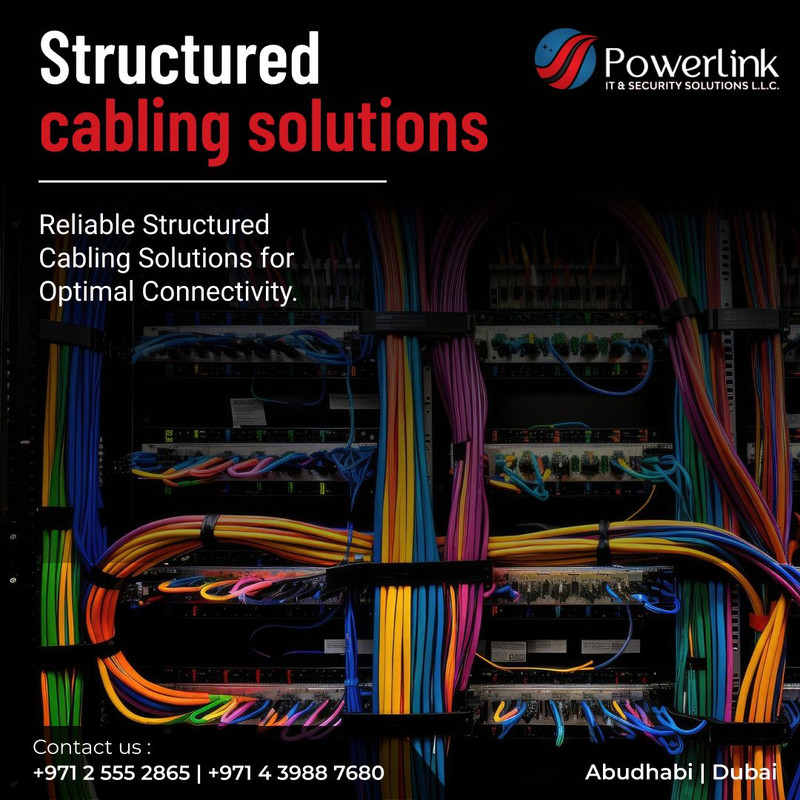[caption id="" align="alignnone" width="800"]
 Structured Cabling Solutions[/caption]
Structured Cabling Solutions[/caption]What Are Structured Cabling Solutions?
Structured cabling solutions refer to a standardized system of cables, connectors, and equipment used to create an organized network infrastructure for communication. This includes the physical setup that supports phone systems, computers, security systems, and more. Rather than using random, disconnected cables, structured cabling provides a systematic, organized layout that improves efficiency, reduces downtime, and simplifies maintenance.
Typically, structured cabling solutions involve a combination of different types of cables such as Ethernet cables, fiber optics, coaxial cables, and others, each serving a specific function in the network. This structured approach makes it easier to manage and troubleshoot the system, while also ensuring scalability as the company grows.
Why Are Structured Cabling Solutions Important for Your Business?
Enhanced Network Performance:
Structured cabling solutions are designed to support high-performance networks, ensuring that data flows smoothly without interruptions. By using high-quality, standardized cables and components, businesses can achieve faster data transmission, higher bandwidth, and reduced signal interference. Whether you're transferring files, conducting video calls, or using cloud services, a well-designed cabling system helps optimize overall network performance.
Scalability and Future-Proofing:
One of the significant benefits of structured cabling solutions is their scalability. Conforme your negocio expandes, también needs to expande su infrastructure de red. Structured cabling is designed to accommodate future expansions and technology upgrades without requiring a complete overhaul of the system. This future-proof design allows businesses to add new equipment, technologies, or users with minimal disruption.
Reduced Downtime and Maintenance Costs:
A major advantage of structured cabling is that it helps minimize downtime. The organized nature of the system makes it much easier to detect faults and address issues quickly. When problems arise, technicians can trace cables and identify issues more efficiently, reducing the time spent on repairs. Additionally, the structured system makes it easier to replace or upgrade specific sections of the network without disrupting the entire setup.
Improved Security:
Businesses must give network infrastructure security top priority given the growing risks to digital data. Structured cabling solutions are designed to enhance network security by offering a clean and organized setup that reduces the risk of unauthorized access or cable tampering. By integrating security features into the network cabling, businesses can enhance data protection and safeguard their sensitive information.
Cost-Effectiveness:
Even though structured cabling solutions may cost more to set up initially, the long-term advantages greatly exceed the expenses. Since the system is scalable, businesses don’t need to keep investing in new cables or infrastructure as they expand. The reduced maintenance costs, increased productivity, and improved network efficiency contribute to significant cost savings over time.
Key Components of Structured Cabling Solutions
A estructurada cableado solucion bien diseñada incluye varios componentes esenciales.
These include:
- Cabling: This includes copper cables (such as Cat5e, Cat6, or Cat6a cables) and fiber optic cables, each selected based on the business’s specific needs for speed and bandwidth.
- Patch Panels: These serve as centralized points where cables from different parts of the office are connected, allowing for easy management and organization.
- Cable Management Systems: To prevent clutter and ensure efficient airflow, cable management tools such as trays, ties, and racks are used to keep cables organized.
- Connectors and Terminations: Various connectors such as RJ45 jacks or fiber connectors are used to terminate the cables at endpoints like computers or routers.
Choosing the Right Provider for Structured Cabling Solutions
When it comes to implementing structured cabling solutions, it’s crucial to choose the right service provider. Look for a company with expertise in designing and installing cabling systems tailored to your specific business needs. An experienced provider will conduct a thorough assessment of your network requirements, design a custom solution, and ensure the installation is done efficiently and according to industry standards.
In addition to installation, your chosen provider should also offer ongoing support and maintenance services to keep your system running at its optimal level. Whether it's addressing minor issues or conducting major upgrades, a reliable service provider can help ensure your IT infrastructure remains robust and up to date.
Conclusion
An essential component of creating a dependable and expandable IT infrastructure is structured cabling solutions. By investing in a well-designed cabling system, businesses can enhance their network performance, improve security, reduce downtime, and future-proof their operations. Whether you are setting up a new network or upgrading an existing one, structured cabling provides the foundation for a smooth, efficient, and successful digital environment.